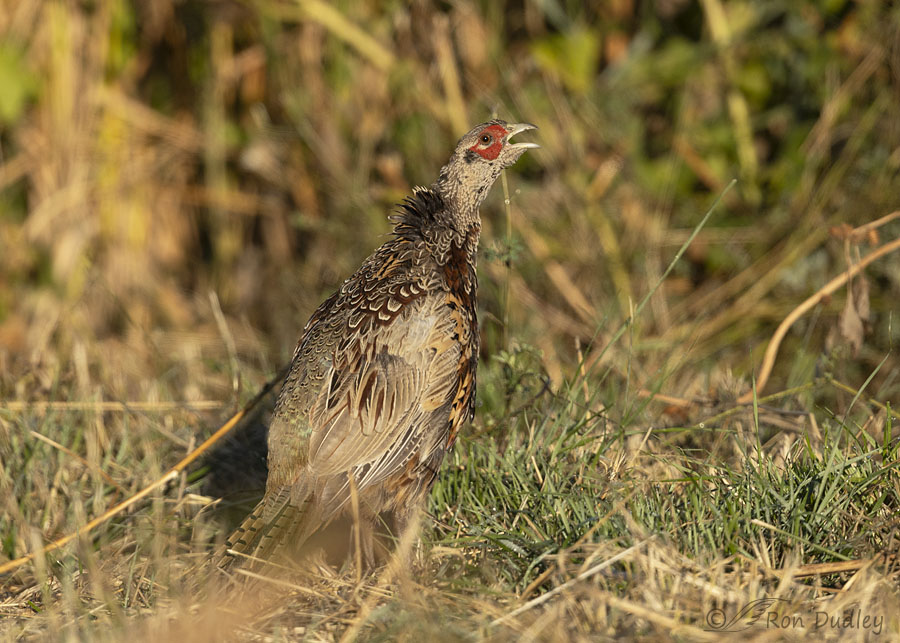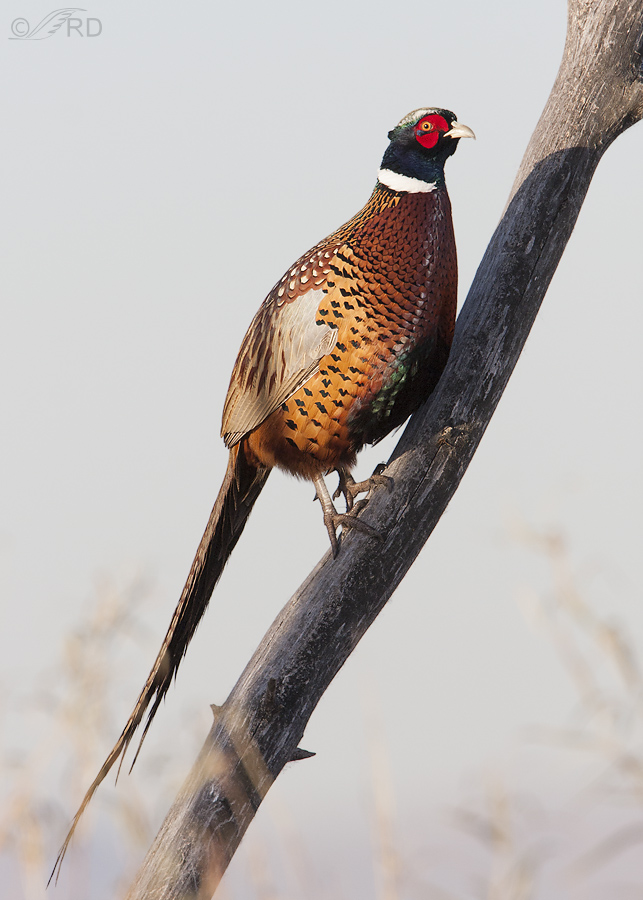A Ring-necked Pheasant developmental stage I’ve never photographed before, at least not very well.

1/5000, f/5.6, ISO 800, Canon R5, Canon EF500mm f/4L IS II USM + 1.4 tc, not baited, set up or called in
Three days ago at Bear River MBR I was lucky to spot this young male Ring-necked Pheasant because he was so well camouglaged in the near-fall colors and warm morning light. I just happened to notice slight movement out of the corner of my eye but even then I had to stare for a few moments before I could make him out.
The setting is busy and I don’t like that vertical stem behind his bill but I found him to be unusually interesting, I’d never before photographed, or seen up close, a young male pheasant at this development stage, with his wattles and papillary skin beginning to turn from pink, to red, and eventually to the scarlet red of the adult male.

1/4000, f/5.6, ISO 800, Canon R5, Canon EF500mm f/4L IS II USM + 1.4 tc, not baited, set up or called in
Unusual for pheasants, he was very patient with me so I got lots of photos. At first he didn’t pose much but eventually he gave me this over the shoulder look, which got rid of that stem behind his bill.

1/5000, f/5.6, ISO 800, Canon R5, Canon EF500mm f/4L IS II USM + 1.4 tc, not baited, set up or called in
Then he practiced his crowing, just like a big boy.

1/5000, f/5.6, ISO 800, Canon R5, Canon EF500mm f/4L IS II USM + 1.4 tc, not baited, set up or called in
I got some preening shots that better revealed that his tail still has a long way to go before it becomes the magnificently long tail of the adult male.

1/4000, f/5.6, ISO 800, Canon R5, Canon EF500mm f/4L IS II USM + 1.4 tc, not baited, set up or called in
He ended up doing some wing-drumming, which is also a typical behavior of adult males.
I didn’t realize it for a long time but eventually I noticed that he wasn’t alone.

1/2500, f/8, ISO 800, Canon R5, Canon EF500mm f/4L IS II USM + 1.4 tc, not baited, set up or called in
There were actually four young males hanging out together but I could never get more than two of them in the frame that were acceptably sharp.
After I’d spent nearly 14 minutes with them, they slowly wandered away and disappeared in the phrags, I enjoyed the fact that they were so comfortable in my presence for so long, which is unusual for pheasants. At least around here.

This is what the young males will soon look like. Their wattles and papillary skin will enlarge and become a bright scarlet, they’ll develop the namesake white ring around their necks, their overall plumage will become significantly more colorful and their tails will become much longer. You can’t see it in my photos, but the young males don’t yet have the spurs on their lower legs that we see in this adult male.
It won’t be long but they’re not there yet.
Ron


Love learning more about bird behavior from you as well as enjoying your photos.
I do love starting my day with education and beauty. Which is why my day almost always starts here. Thank you.
“Which is why my day almost always starts here.”
That warmed my heart, EC.
Wow, another great educational post. Thank you. The last image of the adult almost looks like a painting–it is spectacular.
Linda, interesting that you think that last photo looks like a painting. I’ve always thought the same thing but I don’t remember anyone else ever mentioning it (I’ve posted that older photo before).
I also thought that it was a painting and spent a bit of time looking for the signature of the artist. And then I saw the RD at the top left. A magnificent picture.
These are great shots! I saw so many out there the second day the bay was open for driving. Hunting season starts soon so those that survive will be hard to see. Growing up in Centerville we use to have them in our yard eating at the bird feeders. Too much growth so little habitat now we never see them.
Thanks, April. Now that would be something – having pheasants at your feeders.
Our pheasants are far less numerous than they once were. Some changes in modern agricultural practices has meant that there are fewer hedgerows for them to find refuge. More importantly our Fish and Wildlife department no longer does so many introductions. The first successful introduction of these birds into North America was at a site here in the Willamette Valley about 40 miles north of where I live by Judge Denny in the 1880s. They continued to be introduced but that practice now happens far less often.
“Our pheasants are far less numerous than they once were.”
Dan, I hear the same thing from folks in many different areas and states. Including here in Utah. Hunters complain a lot about it.
Interesting that the first introduction was so close to you.
Super series!
Charlotte Norton
Thanks.
I’m so glad this was your post today. We just got back from Pullman, WA, where we saw pheasants along the highway and in the fields. We were driving, and no binocs, so details were not possible, except for the long tails and white neck rings. It was very exciting to see them. This intermediate stage is beautiful. (Their baby camouflage plumage, with all those browns and tans would make a gorgeous dress fabric).
And catching up on your posts earlier in the week, snipe are related to Woodcocks? They are gorgeous, too. The turkey vultures were wonderful, and congrats on your 1-year back sx anniversary. You’ve given hints along the way, but knowing the extent of your pain and what you’ve been dealing with makes your daily posts even more precious. Thanks!
Carolyn, it sounds like I had good timing with today’s post.
And thank for all the kind words.
VBG! They ARE something of a mess at that stage tho pretty in their own way….. The are generally MUCH spookier than these were for you. Luv you being able to catch the one practicing his crow – it can be god-awful for awhile..
They ARE something of a mess at that stage tho pretty in their own way….. The are generally MUCH spookier than these were for you. Luv you being able to catch the one practicing his crow – it can be god-awful for awhile.. 
Oh! And here was me loving the sound of their crowing greeting me, not only in the morning but throughout the day!
But then, I guess I don’t have an ear for music so maybe that’s why the rusty cowbell sounds lovely to my ear.
Granny Pat, I like the crowing and other calls they make. Unless I flush one almost under my feet and then it scares the poop out of me.
“The are generally MUCH spookier than these were for you.”
That’s for sure, Judy. I was very surprised they tolerated my presence at all, much less for that long.
Excellent photos and post. Glad you got to see that there were more than just the one. I have never seen one and need to hike up into our higher elevations than down by the lakes where I usually hang out. We do have them, but just not where I go.
Thanks, Everett. Hiking up to “higher elevations” sounds like an adventure. Maybe one day I’ll be able to do it again.
Another interesting lesson. This set of photos reveal so much about the plumage of the young male Ring-necked Pheasant; much more than any field guide.
Thank you, Michael.
Even the juveniles are SO BEAUTIFUL ! Though not as colorful
as the mature individuals, In some ways to me they’re more handsome–their patterns really predominate. What a fine experience
for you, and I really enjoyed these photos……
Thanks, Kris. I think the females are attractive too, in a far more subtle way.
What lovely photos! And yes, they are very interesting birds. Since we moved here to the Maritimes I have had them overwintering in the dense tree cover behind my garage and 2 springs ago got 2 females each with a brood so I was lucky enough to get lots of photos as they progressed through the various interesting stages of growth. This past week I saw Daddy and a young male, now nearly indistinguishable except for size and one Mommy and a younger female also almost indistinguishable now. They will definitely keep me entertained all winter long and I hope you too will get another few shots of them.
Thank you, Granny Pat. Sounds like you’ve got a fun and interesting winter ahead of you.
“Then he practiced his crowing, just like a big boy.” This sentence cracked me up. I think he knew he was in your viewfinder and wanted to give you a complete show. So glad you got the chance to photograph these youngsters at such an interesting developmental phase.
I think he knew he was in your viewfinder and wanted to give you a complete show. So glad you got the chance to photograph these youngsters at such an interesting developmental phase.
“This sentence cracked me up.”
Good. The last part of that sentence was an edit, made a few minutes after I published the post. It just seemed like the way to say it…
Very interesting and nice feather detail. I have had them burst out of cover but never saw an immature pose so nicely– and you had four!
Thanks, Kenneth. Yup, that day I was a lucky bird photographer.